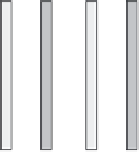Environmental Engineering Reference
In-Depth Information
Therefore, the minimum energy for a given amount of product water from feedwater at
speciic inlet conditions is a complicated function of minimizing the material use and cost
of pretreatment and post-treatment, the energy required, and the capital costs. Therefore,
each location and system typically operates differently.
27.2.3.5 Electrodialysis and Electrodialysis Reversal
Electrodialysis was introduced for industrial desalination applications in the 1960s as a
membrane desalination technique suited to the removal of salt ions from brackish water
[36]. The conceptual idea is based on the iltration mechanism used in medical systems and
the principles for artiicial kidney operation. Electrodialysis systems present the irst evi-
dence of the inluence of bionanotechnology on commercial water desalination processes.
Currently, electrodialysis is listed as a US Environmental Protection Agency (US EPA)
“best available” technology for removal of selenium, barium, nitrate and nitrite, and total
dissolved solids (TDS) for water treatment plants where these concentrations are above
those set by the US EPA for drinking water or for cleanup of reclaimed water for irrigation
or other non-potable uses [37]. The electrodialysis process shown in Figure 27.8 removes
electrically charged salt molecules of saline water by employing alternating stacks of cat-
ionic or anionic selective membranes, with ionic lux driven by an applied electric ield
[23]. As the cations and anions are pulled through the membranes, the salinity of the water
drops at each stage, and freshwater is produced (Figure 27.8). Energy requirements of elec-
trodialysis systems are based on the concentration of ions within the water; thus, electro-
dialysis can be competitive with RO processes at concentrations up to 5000 ppm [36]. A
full membrane stack for this process can be composed of a bank of membranes compris-
ing hundreds of layers of alternating anionic and cationic selective membranes [23]. One
of the main challenges to electrodialysis is the high energy consumption rates needed to
obtain high lux rates of desalted water. High lux demands higher low rates, which are
determined by the applied direct current (DC) at the electrodes. The power consumption
Saline feed
Anion selective
membrane
Cation selective
membrane
DC current
positive pole
DC current
negative pole
Freshwater
Concentrated brine
FIGURE 27.8
Schematic representation of a bank of membranes being used for electrodialysis. (Based on Trieb, F., ed.
Concentrating Solar Power for Water Desalination
. ed. G.A.C. [DLR] and I.O.T. Thermodynamics. Federal Ministry
for the Environment, Nature Conservation and Nuclear Energy: Stuttgart, Germany, 2007.)





















